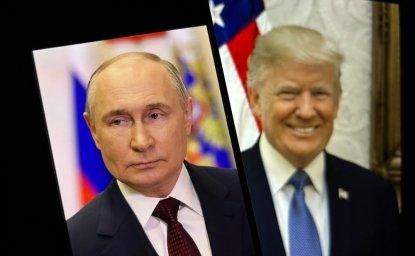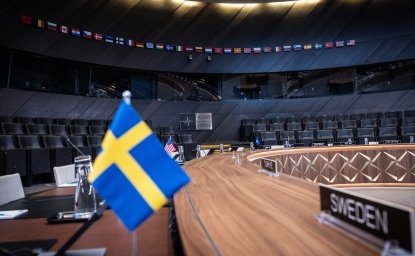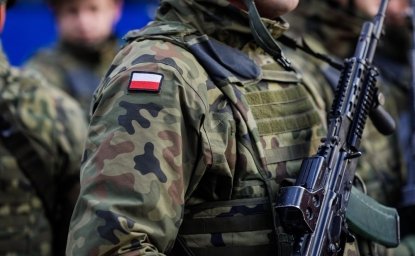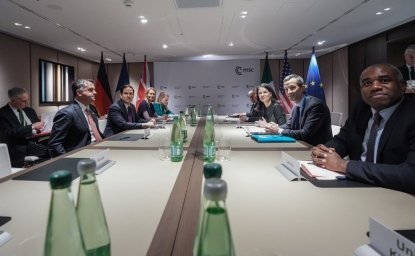NATO 2.0
Last week, the 28-member grouping convened for a biennial summit, this one in Poland, in President Obama’s words, “at the most important moment for our transatlantic alliance since the end of the Cold War.”
Last week, the 28-member grouping convened for a biennial summit, this one in Poland, in President Obama’s words, “at the most important moment for our transatlantic alliance since the end of the Cold War.”
If you are working at North Atlantic Treaty Organization (NATO) Headquarters in Brussels, these are heady and daunting times. If you are Gen. Curtis Scaparrotti, NATO’s military commander, your adrenaline is up, there is urgency in your step, but you may not be getting much sleep. Last week, the 28-member grouping convened for a biennial summit, this one in Poland, in President Obama’s words, “at the most important moment for our transatlantic alliance since the end of the Cold War.”
NATO has had a remarkable history as the world’s most important and most enduring multilateral military alliance. As everyone knows, NATO was conceived and built as a bulwark to defend postwar Western Europe against the aggressive ambitions of the USSR. Those ambitions were not in doubt; Soviet tanks had already rolled across Eastern Europe and were poised to move westward. Communist parties in Italy, France and Greece were actively preparing the political ground. Only a united, determined alliance of European states backed by U.S. military power prevented a Communist takeover of much of the rest of Europe.
When the Berlin Wall came down in 1989 and the Warsaw Pact and the Soviet Union dissolved shortly thereafter, NATO’s vindication was complete. Not surprisingly, this moment of triumph was quickly followed by existential doubt. Without a Soviet adversary, what was NATO’s purpose? Should it also dissolve? Those were not easy questions and influential voices called for NATO to declare its work done. This didn’t happen in large part because the newly liberated countries of Central and Eastern Europe did not want it to happen. Quite the contrary, they wanted NATO to expand to include them. Why? Because history had taught them a hard lesson that they dare not assume the compliant, friendly government that emerged in Moscow in the early 1990s would remain as such. Russia had a history that long predated the USSR of viewing Eastern Europe as its natural sphere of dominance, if not outright occupation. Russian attitudes reflected their own historical experience of invasion eastward across Europe from France (Napoleon) and Germany (Prussia/Hitler).
All this makes it critical that NATO demonstrate that the 21st century version of the alliance can be as effective as its Cold War antecedent.
The Clinton White House and the congressional leadership of the time were very much attuned to the concerns of the post-communist states. U.S. Secretary of State Madeleine Albright had been born in Czechoslovakia, the daughter of a Czech diplomat who defected to America. As a consequence, NATO underwent a rapid and remarkable expansion that encompassed the Eastern and Central European states as well as the Baltics (Estonia, Latvia, and Lithuania). This occurred at a time when the Yeltsin regime in Moscow needed Western support and financing — and when personal relations between leaders in Moscow, Washington, London, Paris and Berlin were quite good. There were angry commentaries from some Russian political and intelligence quarters protesting NATO’s move eastward as a threat and a violation of the terms under which Moscow had agreed to pull its armed forces out of Eastern Europe. A few Russophile voices in American and European academic centers echoed those views. But they did not prevail and the growth of NATO proceeded in an openly celebratory manner. NATO statements ceased to refer to Russia as a potential adversary and a variety of institutional mechanisms were established to facilitate NATO-Russian cooperation. There even was some heady talk that Russia might join the alliance. Europe was whole, free and at peace and NATO had become a kind continental club.
All this ended, quite suddenly, with the emergence of Vladimir Putin as Russia’s new strongman. Putin’s formative career had been in the KGB (stationed in East Germany) and he made no secret of his fierce nostalgia for the Soviet empire and his deep resentment of NATO’s march eastward. Putin operationalized his imperial longings by using Russian proxies to attack Georgia in the Caucuses (2008) and then Ukraine (2014) — culminating in the invasion and occupation of Crimea by Russian Special Forces. At that point, everyone at NATO Headquarters knew that the original mission of the alliance had become relevant once again. For the governments of Eastern and Central Europe, none of this was a complete surprise; they had never trusted Moscow. But that understanding makes the problem all the more urgent. This is particularly true of the small Baltic states with their long history of occupation by Russia and (as a consequence) their large ethnic Russian minorities. Putin defended his invasion of Crimea as necessary to defend Russians living there.
All this makes it critical that NATO demonstrate that the 21st century version of the alliance can be as effective as its Cold War antecedent. That is what the Warsaw summit was all about — reassurance and deterrence. The most important tangible outcome was the creation of NATO battalions of 800-1,200 troops in Poland, Lithuania, Estonia and Latvia, plus a brigade of four more battalions based in Romania and Bulgaria. The battalion in Poland will be commanded by an American and composed of U.S. troops. Already, U.S. NATO units have deployed in a show of force in Eastern and Central Europe, producing (for an American) heartwarming scenes of towns flying American flags and celebrating the appearance of U.S. soldiers in the town square.
The Warsaw summit was an ambitious undertaking and it produced a number of NATO initiatives in the Mediterranean region, North Africa, Iraq and Afghanistan. It also sought to affirm Britain’s strong commitment to the alliance and European security in the wake of Brexit. But the main story was of a revivified alliance defending against a familiar threat.
The opinions expressed here are solely those of the author.
This article originally appeared in The Ellsworth American
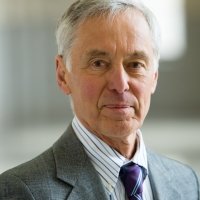

The Indo-Pacific Program promotes policy debate and intellectual discussions on US interests in the Asia-Pacific as well as political, economic, security, and social issues relating to the world’s most populous and economically dynamic region. Read more


The Global Europe Program is focused on Europe’s capabilities, and how it engages on critical global issues. We investigate European approaches to critical global issues. We examine Europe’s relations with Russia and Eurasia, China and the Indo-Pacific, the Middle East and Africa. Our initiatives include “Ukraine in Europe”—an examination of what it will take to make Ukraine’s European future a reality. But we also examine the role of NATO, the European Union and the OSCE, Europe’s energy security, transatlantic trade disputes, and challenges to democracy. The Global Europe Program’s staff, scholars-in-residence, and Global Fellows participate in seminars, policy study groups, and international conferences to provide analytical recommendations to policy makers and the media. Read more

